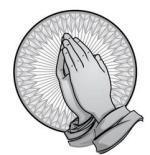Communion with Jesus
THOUGHTFUL THINGS
The Last Supper is recorded in the Gospels (Matthew 26:17–30; Mark 14:12– 26; Luke 22:7–30). It was more than Jesus’ last meal; it was a Passover meal, as well. One of the important moments of the Last Supper is Jesus’ command to remember what He was about to do on behalf of all mankind: shed His blood on the cross thereby paying the debt of our sins.
The Last Supper brought the Old Testament observance of the Passover feast to its fulfillment. Passover was an especially holy event for the Jewish people in that it commemorated the time when God spared them from the plague of physical death and brought them out of slavery in Egypt (Exodus 11:1—13:16). During the Last Supper with His apostles, Jesus took two symbols associated with Passover and showed them a way to remember His sacrifice, after taking the cup, he gave thanks and said, “Take this and divide it among you. For I tell you I will not drink again from the fruit of the vine until the kingdom of God comes.” And he took bread, gave thanks and broke it, and gave it to them, saying, “This is my body given for you; do this in remembrance of me.” In the same way, after the supper he took the cup, saying, “This cup is the new covenant in my blood, which is poured out for you” (Luke 22:17–20).
Jesus’ words during the Last Supper about the unleavened bread and the cup echo what He had said after He fed the 5,000: “I am the bread of life. Whoever comes to me will never go hungry, and whoever believes in me will never be thirsty. Salvation comes through Christ and the sacrifice of His physical body on the cross. Jesus also taught the principles of servanthood and forgiveness as He washed His disciples’ feet: “The greatest among you should be like the youngest, and the one who rules like the one who serves. For who is greater, the one who is at the table or the one who serves? Is it not the one who is at the table? But I am among you as one who serves” (Luke 22:26–27; John 13:1–20).
The Last Supper today is remembered during communion (1 Corinthians 11:23–33). The Bible teaches that Jesus’ death was typified in the offering of the Passover sacrifice (John 1:29). John notes that Jesus’ death resembles the Passover sacrifice in that His bones were not broken (John 19:36; cf. Exodus 12:46). And Paul said, “Christ, our Passover lamb, has been sacrificed” (1 Corinthians 5:7). Jesus is the fulfillment of the Law, including the feasts of the Lord (Matthew 5:17).
The Last Supper was rooted in the Old Covenant even as it heralded the New. Jeremiah 31:31 promised a New Covenant between God and Israel, in which God said, “I will put my law in their minds and write it on their hearts. I will be their God, and they will be my people.” Jesus made a direct reference to this New Covenant during the Last Supper: “This cup Is the new covenant in my blood.” A new dispensation was on the horizon.
The Last Supper was a significant event and proclaimed a turning point in God’s plan for the world. In comparing the crucifixion of Jesus to the feast of Passover, we can readily see the redemptive nature of Christ’s death. As symbolized by the original Passover sacrifice in the Old Testament, Christ’s death atones for the sins of His people; His blood rescues us from death and saves us from slavery. Today, the Lord’s Supper is when believers reflect upon Christ’s perfect sacrifice and know that, through being filled with His spirit and baptized in His name, we will be with Him forever in Haven one day.

